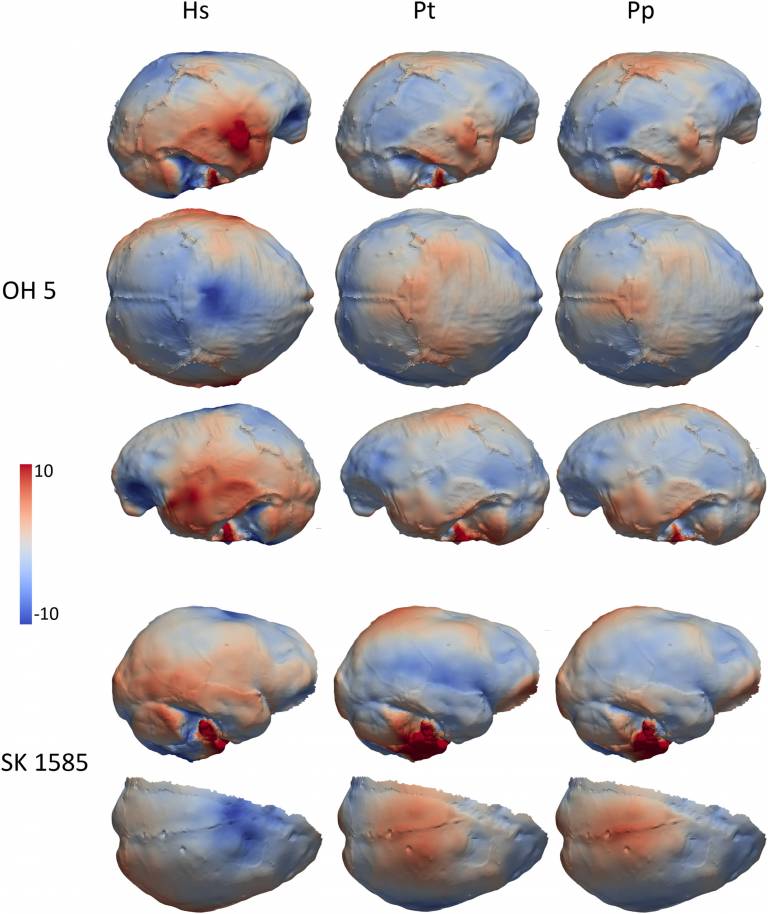The Palaeoneurology of Paranthropus
4 June 2021
The taxonomy, phylogeny, and biology of the Paranthropus species have been the center of debates since the earliest discovery of the TM 1517 cranium (now attributed to Paranthropus robustus) from the Plio-Pleistocene site of Kromdraai (South Africa) in 1938 by R. Broom.

The taxonomy, phylogeny, and biology of the Paranthropus species have been the center of debates since the earliest discovery of the TM 1517 cranium (now attributed to Paranthropus robustus) from the Plio-Pleistocene site of Kromdraai (South Africa) in 1938 by R. Broom (Broom, 1938). In particular, whether Paranthropus boisei and P. robustus represent two distinct taxa, and whether the two species emerged from a common ancestor (i.e., the hypothesis of a monophyletic group) remain largely unresolved (reviewed in Constantino and Wood, 2004, 2007; Wood and Schroer, 2017). Besides the taxonomic and phylogenetic aspects, the presence of two contemporaneous ‘robust’ species in the eastern and southern African hominin fossil records raises critical questions regarding potential occurrences of homoplasies in the hominin clade, with substantial implications for our understanding of early hominin paleobiology (Wood and Schroer, 2017). Moreover, the absence of associated cranial and postcranial remains attributed to Paranthropus complicate the reconstruction of the behavior of this enigmatic ‘megadont’ hominin genus (reviewed in Constantino and Wood, 2007).
In this respect, brain endocasts may have the potential to provide additional insights into the taxonomy, phylogeny, and behavior of Paranthropus taxa. Until now, only a few studies have attempted to assess the evolutionary polarity of the cerebral features in Paranthropus, and even fewer have addressed the question of potential similarities and differences in the brain of the two regional variants of Paranthropus. By investigating the endocasts of Paranthropus aethiopicus, P. boisei, and P. robustus, Falk et al. (2000) suggested similarities between Paranthropus and extant chimpanzees and gorillas (i.e., similar overall endocranial dimensions, beak-shaped profile frontal lobes, rounded temporal poles) and hypothesized a less derived cerebral condition in Paranthropus as compared to Australopithecus. However, the description of the sulcal pattern in P. robustus (SK 1585) revealed a configuration of the lunate sulcus that is more similar to extant humans than to extant chimpanzees, thus suggesting a possible reorganization of the cortical pattern (Holloway, 1972). Nonetheless, it should be noted that there is an ongoing debate as to whether the lunate sulcus is homologous between apes and humans (e.g., Allen et al., 2006; Malikovic et al., 2012) and on the position of the lunate sulcus in early hominins (e.g., Falk, 1980, 1983, 2009; Holloway, 1981; Holloway et al., 2004; Falk et al., 2018; Gunz et al., 2020; but see; Holloway et al., 2016). Interestingly, Holloway (1972) identified critical similarities in the overall shape of the endocast between P. boisei (OH 5) and P. robustus (SK 1585; see Figs. 6-8 in Holloway, 1972), notwithstanding differences in the cerebellum with a rounded shape in P. boisei (Omo L338y-6) and a triangular shape for P. robustus (SK 1585; Holloway, 1972, 1981).
Given the ongoing debate on the evolutionary polarity of the Paranthropus cerebral features, in this paper, we (i) test the hypothesis of a nonhuman, ape-like endocast in Paranthropus and a less derived condition as compared to Australopithecus (Falk et al., 2000), and (ii) investigate further potential morphological similarities between the eastern and southern Paranthropus endocasts (Holloway, 1972). Morphological affinities are quantitatively assessed through the application of a deformation-based method (Durrleman et al., 2012; Beaudet et al., 2016, 2018). Because of their remarkable degree of preservation, we focus our study on the endocasts of OH 5 (P. boisei) and SK 1585 (P. robustus). More specifically, we compare OH 5 and SK 1585 to extant humans, common chimpanzees (Pan troglodytes) and bonobos (Pan paniscus), and to the Australopithecus specimen Sts 5, using statistical shape analyses and colormaps that render global and local morphological differences and similarities between groups/specimens.
A comparative study of the endocasts of OH 5 and SK 1585: Implications for the paleoneurology of eastern and southern African Paranthropus
Amélie Beaudet, Ralph Holloway, Stefano Benazzi
DOI: 10.1016/j.jhevol.2021.103010
 Close
Close

